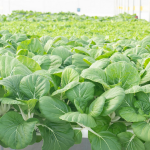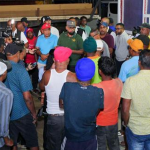Monday May 8, 2017
Mr. Speaker, as I make my contribution to the debate on this motion, permit me to remind this Honourable House of relevant particulars regarding the Authority in question and matters thereto appertaining.
The Mahaica Mahaicony Abary water control project was conceived for facilitating the complete agricultural development of an area of about 450,000 acres of land lying between the Mahaica and Berbice Rivers, on the north-eastern Atlantic seacoast of Guyana. The plans were first outlined in 1952, and the project proposals were first finalized around 1962.
The idea was to provide water control for the coastal lands up to a distance of some 30 miles inland, by impounding the flood waters in surface reservoirs (conservancies) located in the upper reaches of the rivers, and through the construction of appropriate civil engineering infrastructure, provide drainage and irrigation (D&I) services to the areas nearer the coast.
The project was divided into 3 phases with each phases covering an area between two of the rivers, hence the Abary-Berbice, the Mahaicony-Abary, and the Mahaica-Mahaicony areas. In 1977, the Mahaica Mahaicony Abary Agricultural Development Authority (M.M.A./A.D.A) was constituted by statute, as the executing agency for the project (Act 27 of 1977).
In the mid 1980s, Phase 1 (Abary-Berbice) construction works were completed with the establishment of the Abary conservancy, along with the completion of secondary works to facilitate the growing of 37,524 acres of paddy. A further 20,000 acres of private lands have since been cultivated with rice, while extensive livestock rearing has been facilitated. Blairmont estate, which cultivates some 14,000 acres of sugar cane, is also serviced by the Authority.
While only Phase 1 of the project was completed, the areas that are to be included in the other phases, have already had some extent of prior development, and the Authority (MMA/ADA) is responsible for their administration, with particular emphasis on the operation and maintenance (O & M) of the D&I systems. These services support the cultivation of another 30-35,000 acres of rice in these areas, in addition to open range livestock rearing.
The MMA is currently engaged in the construction of new infrastructural works in the Phase 2 (Mahaicony-Abary) area which will facilitate the development of another 15,000 areas of lands.
Overall, the MMA/ADA at present supports nearly half of the national rice production, about 30-35% of all livestock (mostly cattle) production, and 10-15% of national sugar production.
More particularly, the authority is responsible for the operation and maintenance of 784 miles of Drainage and Irrigation canals, 381 structures, including kokers, sluices, bridges, aqueducts and regulators, and 4 pump stations. A total of 169, 878 acres are beneficially occupied for agricultural purposes.
DRAINAGE AND IRRIGATION CHARGES
Mr. Speaker, for more than a decade, farmers were required to pay $2,500 per acre annually ($208 per month) notwithstanding the increasing cost of materials and supplies in the provision for D&I services by the MMA/ADA.
Despite such a low cost for land and drainage and irrigation services provided by the State, some sections of farmers were still not keeping their end of the agreement, by paying their lease rates as stipulated by the Mahaica Mahaicony and Abary/Agricultural Development Authority (MMA/ADA) Act.
As such, this has hampered the Authority from executing planned works outlined in its work program with the most important being the completion of MMA Phases 2 and 3. In this year’s budget the MMA received $357M from Central Government. As the Authority in view of the existing D&I rates and land rent charges, is unable to meet its operating cost.
The MMA – as a statutory agency under the aegis of the Ministry of Agriculture – is required to provide Drainage and Irrigation services within the MMA/ADA area; as laid out in the Authority’s Act. The areas which fall under the MMA purview are:- Abary/Berbice, Abary/Mahaicony and Mahaica/Mahaicony.
The provision of these D&I services are financed from charges levied on the users of the services. No budgetary appropriations are received for D&I services in these blocks. Over the years, the MMA/ADA has faced serious challenges in meeting the expenditure required for fuel and spares for machinery, and increases in salaries/wages of the authority’s workers.
By Cabinet’s decision in 2007, the Authority assumed responsibility for the Mahaica/Mahaicony Block with instructions for the financing responsibilities to be transferred from the RDC Region 5.
Over the past 9 years, extensive infrastructure and other works have been undertaken in the block, to the extent that the cultivated area has doubled. Consequently, the requirement for D&I services has increased and the Region 5 appropriations are inadequate to meet the cost of providing these services.
The new D&I charges for land in the Abary/Berbice area – which receive from the Authority – flood control, primary drainage and irrigation; secondary drainage and irrigation; and primary and secondary access services, range from a high of $8,000 per annum ($666 per month) to $1,000 per annum ($83 per month) based on the location.
Land in the Mahaicony/Abary Block – which receive flood control, dual purpose D&I services and primary and secondary access services, range between $7,000 annually ($583 per month) and $2,500 per annum ($208 per month) based on location.
Land in the Mahaica/Mahaicony area – which receive from the Authority flood control dual purpose D&I and primary and secondary access services attract D&I charges of $5,000 per annum ($416 per month).
Surely, Mr. Speaker, these charges cannot be considered onerous. Indeed, some people might consider such monthly charges for one-acre of land – the equivalent of 8 full house lots or 16 half lots as obtains in our capital city of Georgetown; – as ridiculously low.
LAND RENTAL CHARGES
Let us now, Mr. Speaker, consider land rental charges. In 1998, land rental charges were fixed at $1,000 per acre per annum ($83 per month). Shortly thereafter, it was argued at the level of the MMA/ADA Board that the rental for land for pasturage should be reduced. The Board agreed to reduce the land rental charges for pasture to $200 per acre ($17 per month). These charges have remained for the past 18 years.
The Rice Farmers (Security of Tenure) Act, Cap:69:02 is intituled: “an Act to provide better security of tenure for tenant rice farmers; to limit the rent payable for the letting of rice lands; and for matters connected with the matters aforesaid”. The guidelines for basic rental (per acre per annum) are set out in the First Schedule of the Act and are expressed in bags (units are in 140 pound bags of paddy) based on approximately five percent of the quantity of paddy produced in one two-crop year.
Applying the guidelines as set out in Chapter 69:02 of the Laws of Guyana to determine the basic rental of rice lands in the MMA area require that, based on the national average yield of 35 bags per acre per crop (70 bags per annum), 5% of yield would attract a charge of 3.5 bags of paddy per acre per year. As the value of one bag of paddy ranges between $2,000 and $3,000 per bag, and conservatively using the lowest rate of $2,000 a rental of $7,000 per annum (or $583 per month) can legally, and appropriately be applied.
In view of the fact that the MMA Board had previously determined that the rental for pasturage should be 20% of that for rice, the new rate for pasture land in the MMA area has been determined at $1,400 per acre per annum ($117 per month).
Again, Mr. Speaker, I humbly submit that by no stretch of the imagination and under no set of circumstances can these charges be considered exorbitant or present a burden on stakeholders.
In summary, Mr. Speaker, the total of D&I and land rental charges per acre in the MMA area range from $15,000 per annum ($1,250 per month) to $12,000 per annum ($1,000 per month) for rice lands; and between $9,400 per annum ($783 per month) and $6,400 per annum ($583 per month) for pasturage.
Mr. Speaker, permit me to address what this means financially. Figures obtained from the Guyana Rice Development Board indicate that the average price for paddy in region 5 in 2016 was $2,900 per bag, the equivalent of an annual income of $203,000 per acre.
In agriculture, the three main factors of production are land, labour and capital with land being the most important of these, since without it not one grain of paddy could be produced. With the cost of land rent and D&I charges being less than 10% of average income per acre per annum, the fees could not possibly be burdensome on any farmer.
But perhaps, Mr. Speaker, the main concern regarding the increase in D&I and land rental charges might be due to the lobbying of those who are involved in the illegal practice of sub-letting of leased lands in the MMA area.
Clause 4 of the Lease of State Land for Agricultural Purposes (M.P. No. MMA: 5/L.B.A.R/2025) issued under section 3(b) of the State Lands Act. Chapter 62:01 and in accordance with the Mahaica, Mahaicony Abary Agricultural Development Authority Act No 27 of 1977 states:
“The lessee shall not sub-let, assign or give possession of the land hereby leased or any other part thereof without the previous written consent of the lessor.”
While the Authority has on record only one instance of authorized sub-letting, the incidence of this practice might be quite common in the area at a rental of $8,000 per acre per crop or $16,000 per annum. The increase in the fees to $15,000 per annum will severely compromise the illegal returns from this practice. It does, however, indicate that bona fide farmers are quite content in paying D&I rates and land rental in excess of those instituted.
Mr. Speaker, the MMA/ADA is a public corporation via the Public Corporations Act Cap 19:05. Under Section 30 of that Act, a corporation of this nature may charge fees for any service rendered. This is done with approval of the Minister.
The MMA/ADA Act Cap 70:01 was enacted to establish the MMA/ADA and to ensure the smooth functioning of that organization. According to the Public Corporations Act, Section 12 (1), such organizations have a duty to stimulate, facilitate and undertake the purpose for which they were established.
In order to effectively carry out its functions as a body corporate, sufficient drainage and irrigation and land rent charges must be collected by the MMA/ADA to facilitate further development of the agriculture sector. According to the draft National Strategy for Agriculture in Guyana 2016-2020, (Development and Maintenance of Agricultural Infrastructure), pg.58, financing is required for the successful completion of Phases 2 and 3 of the MMA/ADA strategic plan. This can only become a reality with legitimate increased drainage and irrigation and land rent charges.
Further, the Agriculture Sector in the National Strategy for Agriculture in Guyana 2013-2020, is mandated to change the view that agriculture is for subsistence livelihood since it seeks to promote agriculture as a wealth generator and entrepreneurial enterprise, producing food and non-food commodities to meet local and export demands. If this is to become a reality for small farmers, then there needs to be improved drainage and irrigation services which can only be possible if the operating and maintenance costs of the infrastructure are taken into consideration. Therefore, increased drainage and irrigation charges and land rentals are required.
Mr. Speaker, for these reasons I cannot recommend support for this motion by this Honourable House.
NLH





